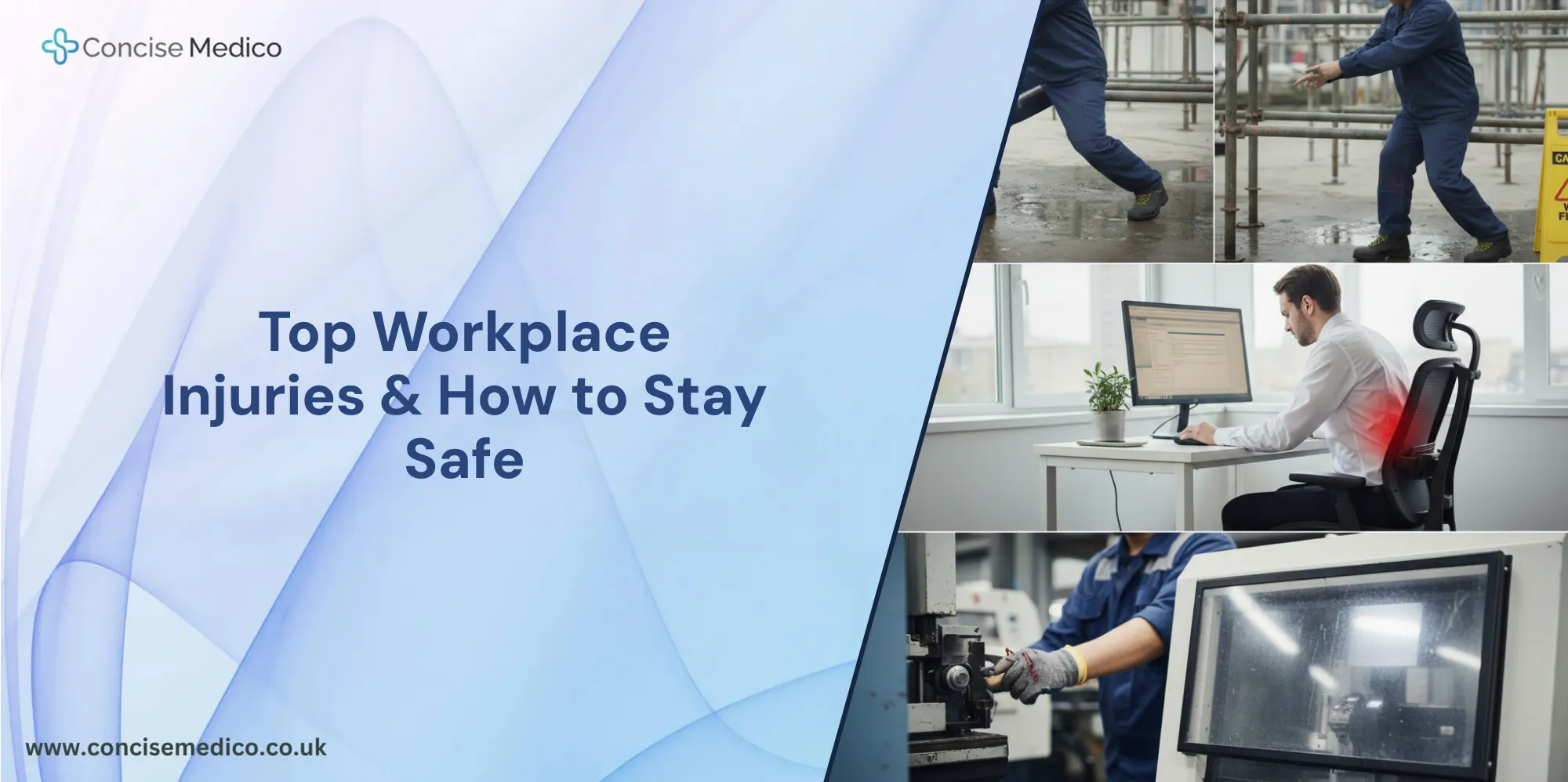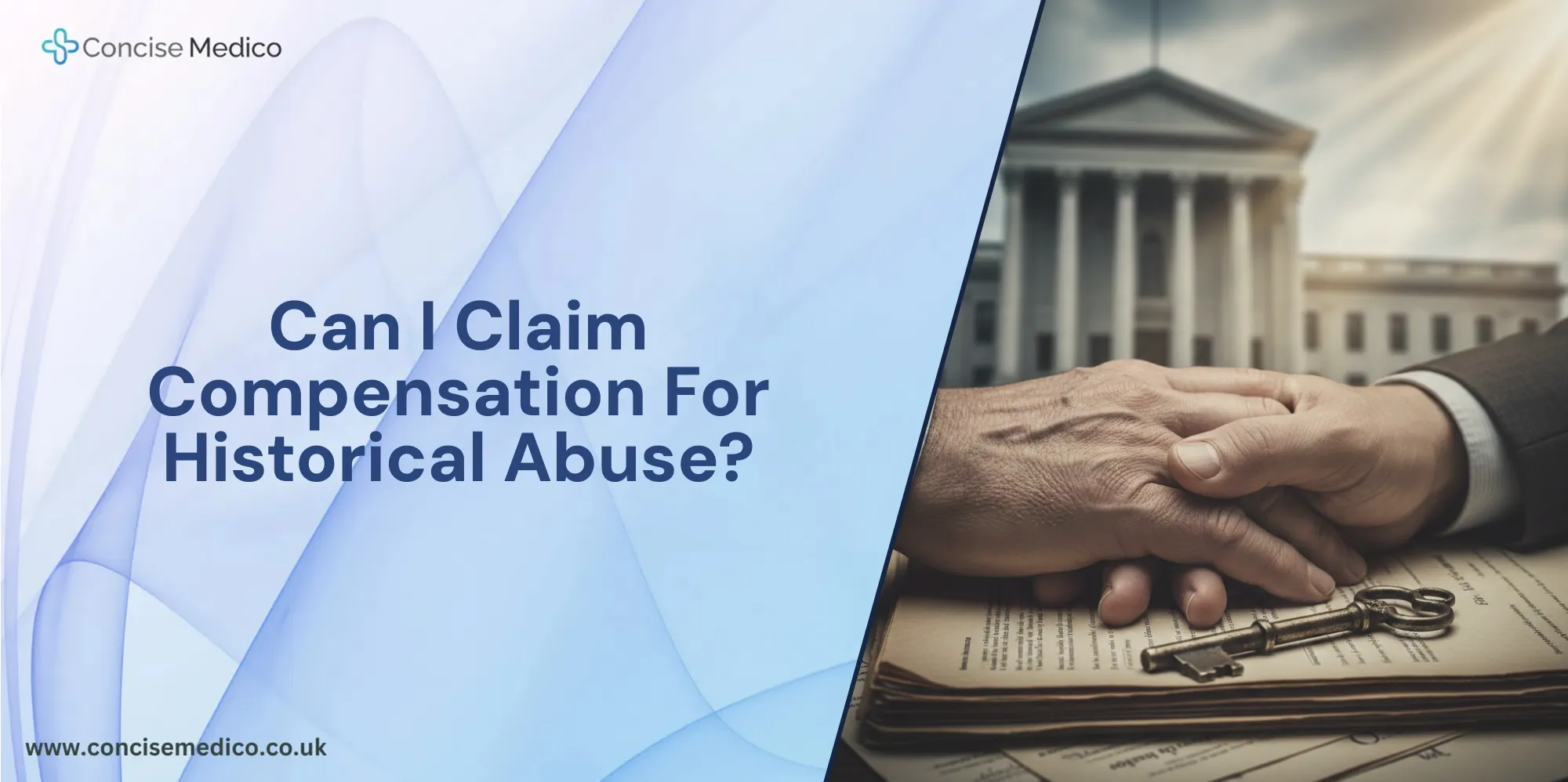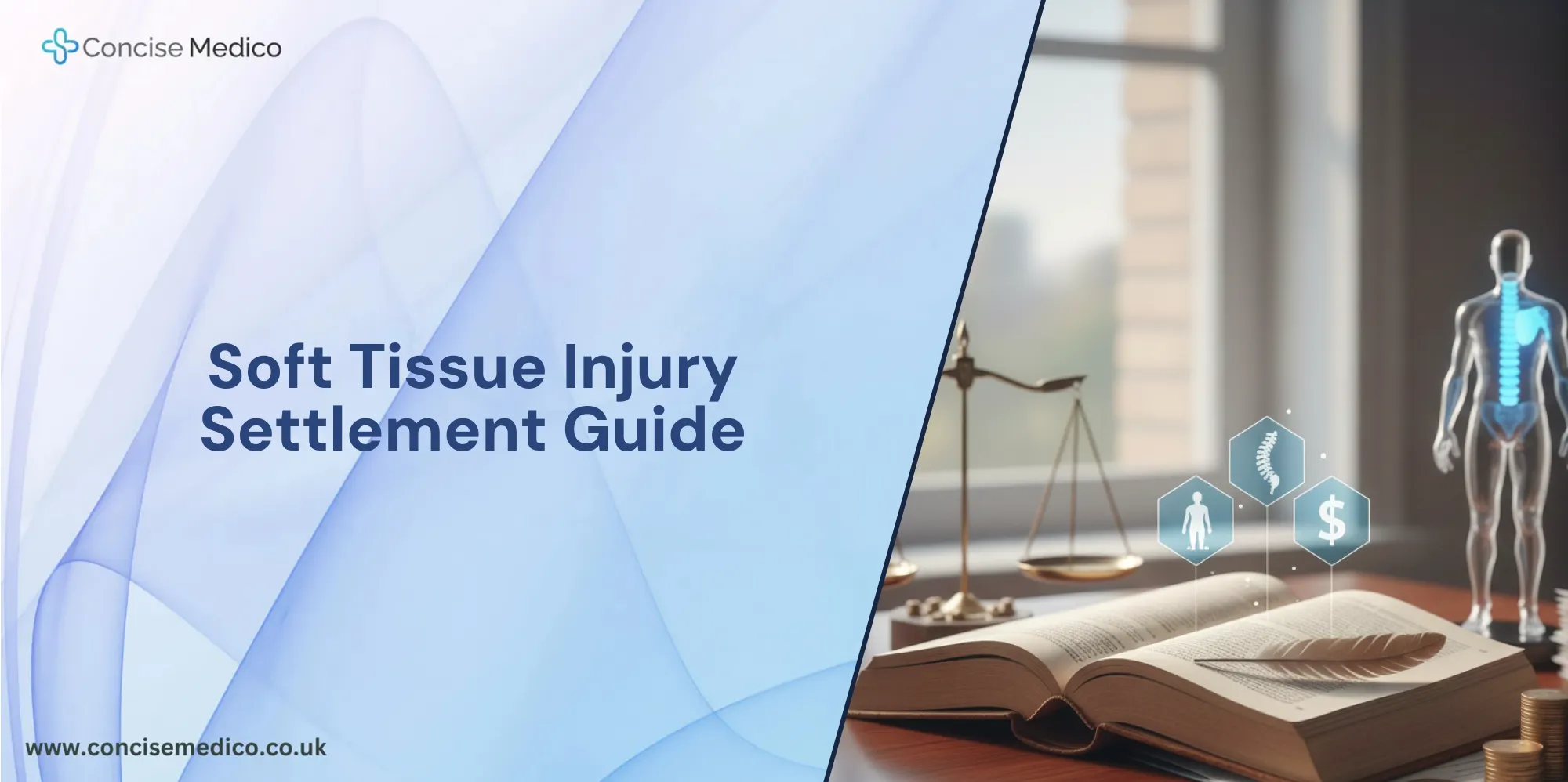TABLE OF CONTENT
A personal injury medical report is vital in UK legal cases. A personal injury report tells how the injury took place, how serious it is, and how it impacts everyday life. It also helps to calculate costs. This covers medical treatment, lost wages, and future treatment needs. Some reports focus on the nature and extent of the injury. Others assess liability and break down financial losses. Each type of report plays a key role in building a clear, fair case for court.
Know more about Personal Injury Claim
Types of Personal Injury Medical Reports
1. Clinical Reports
Purpose of Clinical Reports
Clinical reports are created by doctors who treated the injury first. These reports show the injuries found and how they were treated. Courts use them to check if the claimant really faced harm. It provides details about the time of injury and its severity.
What’s Included
- Description of physical injuries
- Medical exams and test results
- Surgery or treatment received
- Prescribed medicines and therapies
These reports form the basis of most medico legal report personal injury claims. Following are details included in the report.
Types of Injury
A personal injury report includes details on minor cuts and bruises to broken limbs, head, and spinal cord injuries. They show visible injuries and also try to uncover any hidden issues from the accident.
Type of Treatment
Clinical reports list the treatments the claimant has gone through in detail. These may consist of:
- Emergency Care
- Surgeries
- Physical Therapy
- Long-term Medication
This section indicates if the injury needs advanced treatments, showing its severity.
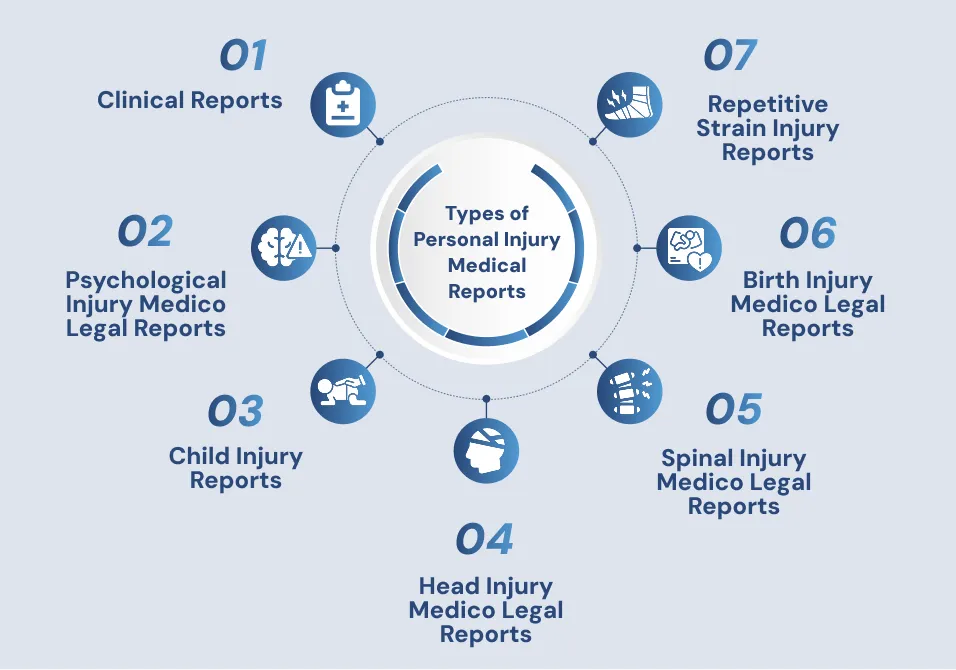
Timelines for Recovery
Recovery timelines help explain how the injury impacts the claimant’s life. The report will state:
- How long it should take to fully recover
- Permanent impairments expected
- Future treatments that may be required
These details help legal experts to figure out compensation. They can add the time someone is unable to work or do daily chores.
Clinical Reports and Legal Use
Judges read these reports to learn about the medical events. Without them, it’s hard to prove that an injury really occurred. They also help other experts build on their own assessments.
UK Trends in Clinical Report Use
In 2023, medico legal reports made up over 16,000 personal injury claims in the UK. This shows how vital clinical reports are in these serious accident claims.
Types of Clinical Reports
Rehabilitation Reports
Therapy details go into a personal injury medical report. They show how treatment progress relates to the original harm. Rehab reports show how the injured person is healing. They outline each step of therapy and how the patient is responding to that treatment. These reports help track recovery and support therapy costs.
Components of the Report
- Progress reports from therapists
- Missed sessions or setbacks
- Future rehab needs
It shows whether the person followed the care plan, which can affect the claim. This makes a clear personal injury medical report crucial when claiming ongoing rehab costs.
Types of Intervention
These mostly refer to rehab reports. They show what type of therapy was used to treat the injury. This can be among many types including:
- Physiotherapy
- Occupational Therapy
- Counselling
- Hydrotherapy
This shows how treatment helps the claimant recover and reach their goals.
Monitoring of Progress
This personal injury medical report tracks the claimant’s treatment progress. It notes improvements and setbacks over time. Rehab notes show how the patient responds to each care step. They also note if changes to the plan are vital.
Patient Compliance
Patient compliance is one of the most important points in rehab notes. If a claimant does not stick to their treatment plan, it may affect their reward. These reports will show if the claimant goes to sessions, does exercises, and takes medicines. This gives an overview of their recovery effort. Rehab reports will document:
- Attendance at therapy sessions
- Adherence to prescribed exercises
- Any issues related to non-compliance
Other Common Types of Clinical Reports
Clinical reports can be grouped by their medical specialty or context. Each type looks at a specific part of the injury or treatment process. This helps create a more detailed and accurate medico-legal assessment.
| Type of Clinical Report | Description |
|---|---|
| General Practitioner (GP) Report | Prepared by the claimant’s regular doctor. Gives an overview of injury history and basic treatment. |
| Emergency Care Report | Created after treatment in A&E or urgent care. Covers initial diagnosis and emergency intervention. |
| Orthopaedic Report | Focuses on musculoskeletal injuries such as fractures, dislocations, or joint damage. |
| Neurological Report | Assesses nerve, spinal, or brain damage and related symptoms like numbness or cognitive issues. |
| Surgical Report | Details any surgical procedures undertaken due to the injury. |
| Physiotherapy/Physical Therapy Report | Covers physical rehabilitation treatments following musculoskeletal or spinal injuries. |
| Occupational Health Report | Evaluates how injuries affect work capacity and return-to-work potential. |
| Pain Management Report | Provides specialist insights when pain is chronic and requires targeted treatment or medication. |
| Dermatological Report | Used when skin injuries, burns, or scarring are involved. |
| ENT or Ophthalmology Report | Relevant for injuries affecting ears, nose, throat, or eyes. |
2. Psychological Injury Medico Legal Reports
When someone is hurt, it can affect their mind too. These reports explain trauma, stress, or mental health issues caused by the event. Courts need this to assess emotional damage, which may not be visible.
Components of the Report
- Interviews and therapy notes
- Anxiety, depression, or PTSD signs
- Impact on daily life
- Recovery estimates
Assessment Tools
In a personal injury medical report, tools test the claimant’s mental health. This is done through tests, interviews, and therapy sessions. These tools let the medico-legal expert assess the level of mental harm. They help determine if there could be lasting effects.
Coping Mechanism
The psychological sections of personal injury medical reports show how the claimant copes with trauma. Some claimants manage well, while others struggle with anxiety, depression, or PTSD. This part reveals their mental state and any therapy or intervention they may need.
Referral Options
A personal injury medical report might mention the need for extra mental support. You can refer the patient to a mental health expert or suggest longer treatment. These tests ensure claimants get the help they need for emotional and physical recovery.
3. Child Injury Reports
Injuries in children need special attention. Personal injury medical reports for children take into account special needs. This includes their growth, learning, and behavior. These reports explore how the injury may affect school and family life. They check how the injury impacts the child’s physical, emotional, and cognitive growth.
Components of the Report
- Missed classes
- Trouble with focus or memory
- Family stress
- Need for special help
The report must be age-related and include teacher or doctor feedback.
Age-Specific Assessments
A personal injury medical report shows how harm might affect their body and mind over time as they grow. Since children are still growing, an injury can change their body and thinking. This part of the report looks at how that harm could affect a child’s milestones and shape their future skills.
Educational Impact
The personal injury medical report also looks at how the injury affects a child’s schooling. Missing classes or changes in thinking skills can disrupt learning. It gives advice on support or special arrangements to help the child catch up.
Family Dynamics
A report shows how the injury can change life for everyone at home. Parents may feel more stress, and siblings can worry too. Daily routines often shift to focus on medical appointments or extra care. The report details these shifts and notes if the family needs extra help to cope.
4. Head Injury Medico Legal Reports
The report for head injuries focuses on brain harm, such as concussions or trauma. These personal injury reports describe how severe the injury and nerve damage are. They also show the long lasting effects on cognitive functions. When there is permanent harm or a person needs care for life, these head injury reports are vital.
Components of the Report
- MRI or CT scan results
- Speech, memory, or balance problems
- Long-term care plans
- Risk of permanent disability
These reports help courts decide how serious the impact truly is.
5. Spinal Injury Medico Legal Reports
A personal injury medical report for spinal injuries looks at the back, nerves, and spine. Damage here can cause paralysis or long lasting pain. These injuries often happen at work or in car crashes. The report checks muscles, nerves, and the spine to see how much harm occurred. It also includes reduced mobility and trouble with daily tasks. Severe back injuries often need long rehab. They may lead to permanent disability. These are among the highest-cost claims due to long-term care needs.
Components of the Report
- Movement tests
- Nerve damage results
- Wheelchair use or home changes
- Employment impact
Such reports are often key in quantum reports personal injury cases.
6. Birth Injury Medico Legal Reports
These reports cover harm during childbirth. These can affect the mother or baby. The report explains what went wrong and how it may affect the future.
Components of the Report
- Mistakes during delivery
- Damage to limbs or brain
- Missed warning signs
- Long-term support needed
Montgomery v. Lanarkshire Health Board (2015) Case
In this case, Mrs. Montgomery wasn’t told there was a 9–10% risk of her baby’s shoulder getting stuck in birth. Because of this, the baby suffered serious injuries. The Supreme Court ruled doctors must tell patients all important risks and options so they can make informed choices.
7. Repetitive Strain Injury Reports
RSI reports deal with damage from doing the same action for too long. RSIs are a common injury in work-related personal injury cases. It occurs with repetitive movement injuries to muscles, nerves, or tendons. RSI reports detail how severe the injury is, the claimant’s recovery plan, and if the client can go back to work. These reports are key for personal injury claims in the UK. They focus on workplace safety and negligence. The report explains the harm, treatment, and job limits caused.
- Pain in wrists, arms, or neck
- Loss of movement or grip
- Missed work and job changes
- Risk of future problems
These reports are vital to workplace claims under UK safety laws.
Legal Reports Supporting Personal Injury Claims
1. Liability Reports
Role in Legal Cases
Liability reports prove who caused the injury. The report links the injury to the event, such as a car crash or work accident. During the proof collection phase after the injury, these reports are used to identify who was at fault and to build the legal case. These reports show if the other side caused the harm. They lay out each step in order so the judge can see what took place.
Evidence Gathered
- CCTV or photos
- Witness or police reports
- Timeline and accident details
- The injured person’s statement
A carefully crafted personal injury medical report can show that the injury was not the victim’s fault.
Claimant’s Case
Liability reports include the account of the claimant. This part explains how the incident happened from their point of view and how it has affected their life. Knowing the claimant’s account helps clarify how the injury occurred.
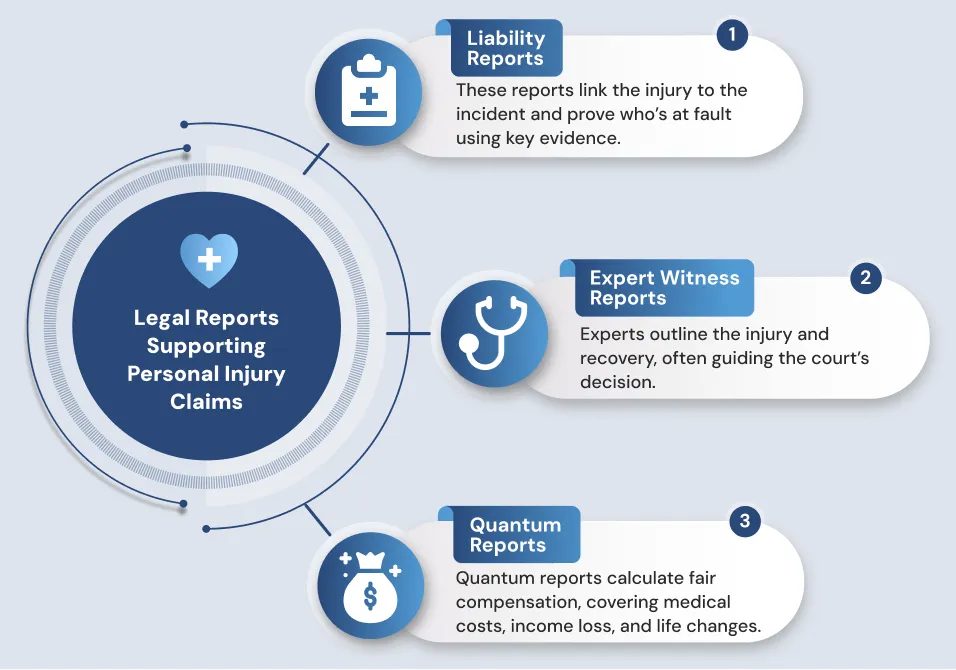
2. Expert Witness Reports
What Experts Do
Doctors, surgeons, and specialists create expert witness reports. These reports explain the injury in clear, simple terms. These are mostly shown to the court. They help explain complex medical issues related to the injury or any technical matters. They help the court grasp complex medical facts. They also predict recovery outcomes.
Components of the Report
- Scan or test details
- Expected recovery timeline
- Effect on working ability
- Risk of long-term issues
Experts may also testify in court, using the report as a reference. Their findings often shape the final legal result.
Presentation of Evidence
These personal injury medical reports use clear words to link medical findings directly to the accident. They clearly show how the claimant was harmed and explain their condition simply. The report clearly shows that the claimant’s injuries match the accident. For complex or hidden injuries, this report becomes essential evidence.
Preparation of Cross Examination
In a court case, the expert must be ready to defend the personal injury medical report. The write-up must cover every detail of the injury and its cause. The expert should use firm and plain words when answering questions. This way, the findings can stand firm under cross-examination by the other side.
3. Quantum Reports
Purpose of Quantum Reports
The report calculates how much the injured person should be paid. It includes short-term and long-term costs. These costs can cover medical bills, work loss, and life changes.
What’s Measured
- Past and future medical bills
- Therapy and rehab costs
- Loss of income
- Cost of home changes or devices
This report shows that the compensation covers the full impact of the injury.
Compensation Computation
These reports provide computation details. This helps estimate the reward for the claimant. The following points are mostly mentioned in the report:
- Treatment of the disease
- Severity of injury
- Period of recovery time
- Long-term disability
This ensures that the harmed claimant is given enough compensation, as reported.
Why These Personal Injury Medical Reports Matter
Each personal injury medical report provides expert-backed proof of harm and need. Personal injury medical reports are the foundation of legal claims in the UK. They show the court clear proof of what happened. They explain how it changed someone’s life. They also detail what support is now needed. Without these reports, it would be hard to get fair compensation. As said by NHS:
“Claims for clinical negligence compensation are often complex and may require expert evidence, particularly in respect to causation.”
NHS Resolution, Advice for claimants (2025)
Each personal injury report brings vital details. They help lawyers create strong cases. They also ensure victims get full support. If you need a trusted partner for creating accurate personal injury medical reports, contact us. Concise Medico provides CPR-compliant documents, adapted to every case.
FAQs
A personal injury medical report is vital in UK legal cases. A personal injury report tells how the injury took place, how serious it is, and how it impacts everyday life. It also helps to calculate costs. This covers medical treatment, lost wages, and future treatment needs. Some reports focus on the nature and extent of the injury. Others assess liability and break down financial losses. Each type of report plays a key role in building a clear, fair case for court.
Know more about Personal Injury Claim
Types of Personal Injury Medical Reports
1. Clinical Reports
Purpose of Clinical Reports
Clinical reports are created by doctors who treated the injury first. These reports show the injuries found and how they were treated. Courts use them to check if the claimant really faced harm. It provides details about the time of injury and its severity.
What’s Included
- Description of physical injuries
- Medical exams and test results
- Surgery or treatment received
- Prescribed medicines and therapies
These reports form the basis of most medico legal report personal injury claims. Following are details included in the report.
Types of Injury
A personal injury report includes details on minor cuts and bruises to broken limbs, head, and spinal cord injuries. They show visible injuries and also try to uncover any hidden issues from the accident.
Type of Treatment
Clinical reports list the treatments the claimant has gone through in detail. These may consist of:
- Emergency Care
- Surgeries
- Physical Therapy
- Long-term Medication
This section indicates if the injury needs advanced treatments, showing its severity.

Timelines for Recovery
Recovery timelines help explain how the injury impacts the claimant’s life. The report will state:
- How long it should take to fully recover
- Permanent impairments expected
- Future treatments that may be required
These details help legal experts to figure out compensation. They can add the time someone is unable to work or do daily chores.
Clinical Reports and Legal Use
Judges read these reports to learn about the medical events. Without them, it’s hard to prove that an injury really occurred. They also help other experts build on their own assessments.
UK Trends in Clinical Report Use
In 2023, medico legal reports made up over 16,000 personal injury claims in the UK. This shows how vital clinical reports are in these serious accident claims.
Types of Clinical Reports
Rehabilitation Reports
Therapy details go into a personal injury medical report. They show how treatment progress relates to the original harm. Rehab reports show how the injured person is healing. They outline each step of therapy and how the patient is responding to that treatment. These reports help track recovery and support therapy costs.
Components of the Report
- Progress reports from therapists
- Missed sessions or setbacks
- Future rehab needs
It shows whether the person followed the care plan, which can affect the claim. This makes a clear personal injury medical report crucial when claiming ongoing rehab costs.
Types of Intervention
These mostly refer to rehab reports. They show what type of therapy was used to treat the injury. This can be among many types including:
- Physiotherapy
- Occupational Therapy
- Counselling
- Hydrotherapy
This shows how treatment helps the claimant recover and reach their goals.
Monitoring of Progress
This personal injury medical report tracks the claimant’s treatment progress. It notes improvements and setbacks over time. Rehab notes show how the patient responds to each care step. They also note if changes to the plan are vital.
Patient Compliance
Patient compliance is one of the most important points in rehab notes. If a claimant does not stick to their treatment plan, it may affect their reward. These reports will show if the claimant goes to sessions, does exercises, and takes medicines. This gives an overview of their recovery effort. Rehab reports will document:
- Attendance at therapy sessions
- Adherence to prescribed exercises
- Any issues related to non-compliance
Other Common Types of Clinical Reports
Clinical reports can be grouped by their medical specialty or context. Each type looks at a specific part of the injury or treatment process. This helps create a more detailed and accurate medico-legal assessment.
| Type of Clinical Report | Description |
|---|---|
| General Practitioner (GP) Report | Prepared by the claimant’s regular doctor. Gives an overview of injury history and basic treatment. |
| Emergency Care Report | Created after treatment in A&E or urgent care. Covers initial diagnosis and emergency intervention. |
| Orthopaedic Report | Focuses on musculoskeletal injuries such as fractures, dislocations, or joint damage. |
| Neurological Report | Assesses nerve, spinal, or brain damage and related symptoms like numbness or cognitive issues. |
| Surgical Report | Details any surgical procedures undertaken due to the injury. |
| Physiotherapy/Physical Therapy Report | Covers physical rehabilitation treatments following musculoskeletal or spinal injuries. |
| Occupational Health Report | Evaluates how injuries affect work capacity and return-to-work potential. |
| Pain Management Report | Provides specialist insights when pain is chronic and requires targeted treatment or medication. |
| Dermatological Report | Used when skin injuries, burns, or scarring are involved. |
| ENT or Ophthalmology Report | Relevant for injuries affecting ears, nose, throat, or eyes. |
2. Psychological Injury Medico Legal Reports
When someone is hurt, it can affect their mind too. These reports explain trauma, stress, or mental health issues caused by the event. Courts need this to assess emotional damage, which may not be visible.
Components of the Report
- Interviews and therapy notes
- Anxiety, depression, or PTSD signs
- Impact on daily life
- Recovery estimates
Assessment Tools
In a personal injury medical report, tools test the claimant’s mental health. This is done through tests, interviews, and therapy sessions. These tools let the medico-legal expert assess the level of mental harm. They help determine if there could be lasting effects.
Coping Mechanism
The psychological sections of personal injury medical reports show how the claimant copes with trauma. Some claimants manage well, while others struggle with anxiety, depression, or PTSD. This part reveals their mental state and any therapy or intervention they may need.
Referral Options
A personal injury medical report might mention the need for extra mental support. You can refer the patient to a mental health expert or suggest longer treatment. These tests ensure claimants get the help they need for emotional and physical recovery.
3. Child Injury Reports
Injuries in children need special attention. Personal injury medical reports for children take into account special needs. This includes their growth, learning, and behavior. These reports explore how the injury may affect school and family life. They check how the injury impacts the child’s physical, emotional, and cognitive growth.
Components of the Report
- Missed classes
- Trouble with focus or memory
- Family stress
- Need for special help
The report must be age-related and include teacher or doctor feedback.
Age-Specific Assessments
A personal injury medical report shows how harm might affect their body and mind over time as they grow. Since children are still growing, an injury can change their body and thinking. This part of the report looks at how that harm could affect a child’s milestones and shape their future skills.
Educational Impact
The personal injury medical report also looks at how the injury affects a child’s schooling. Missing classes or changes in thinking skills can disrupt learning. It gives advice on support or special arrangements to help the child catch up.
Family Dynamics
A report shows how the injury can change life for everyone at home. Parents may feel more stress, and siblings can worry too. Daily routines often shift to focus on medical appointments or extra care. The report details these shifts and notes if the family needs extra help to cope.
4. Head Injury Medico Legal Reports
The report for head injuries focuses on brain harm, such as concussions or trauma. These personal injury reports describe how severe the injury and nerve damage are. They also show the long lasting effects on cognitive functions. When there is permanent harm or a person needs care for life, these head injury reports are vital.
Components of the Report
- MRI or CT scan results
- Speech, memory, or balance problems
- Long-term care plans
- Risk of permanent disability
These reports help courts decide how serious the impact truly is.
5. Spinal Injury Medico Legal Reports
A personal injury medical report for spinal injuries looks at the back, nerves, and spine. Damage here can cause paralysis or long lasting pain. These injuries often happen at work or in car crashes. The report checks muscles, nerves, and the spine to see how much harm occurred. It also includes reduced mobility and trouble with daily tasks. Severe back injuries often need long rehab. They may lead to permanent disability. These are among the highest-cost claims due to long-term care needs.
Components of the Report
- Movement tests
- Nerve damage results
- Wheelchair use or home changes
- Employment impact
Such reports are often key in quantum reports personal injury cases.
6. Birth Injury Medico Legal Reports
These reports cover harm during childbirth. These can affect the mother or baby. The report explains what went wrong and how it may affect the future.
Components of the Report
- Mistakes during delivery
- Damage to limbs or brain
- Missed warning signs
- Long-term support needed
Montgomery v. Lanarkshire Health Board (2015) Case
In this case, Mrs. Montgomery wasn’t told there was a 9–10% risk of her baby’s shoulder getting stuck in birth. Because of this, the baby suffered serious injuries. The Supreme Court ruled doctors must tell patients all important risks and options so they can make informed choices.
7. Repetitive Strain Injury Reports
RSI reports deal with damage from doing the same action for too long. RSIs are a common injury in work-related personal injury cases. It occurs with repetitive movement injuries to muscles, nerves, or tendons. RSI reports detail how severe the injury is, the claimant’s recovery plan, and if the client can go back to work. These reports are key for personal injury claims in the UK. They focus on workplace safety and negligence. The report explains the harm, treatment, and job limits caused.
- Pain in wrists, arms, or neck
- Loss of movement or grip
- Missed work and job changes
- Risk of future problems
These reports are vital to workplace claims under UK safety laws.
Legal Reports Supporting Personal Injury Claims
1. Liability Reports
Role in Legal Cases
Liability reports prove who caused the injury. The report links the injury to the event, such as a car crash or work accident. During the proof collection phase after the injury, these reports are used to identify who was at fault and to build the legal case. These reports show if the other side caused the harm. They lay out each step in order so the judge can see what took place.
Evidence Gathered
- CCTV or photos
- Witness or police reports
- Timeline and accident details
- The injured person’s statement
A carefully crafted personal injury medical report can show that the injury was not the victim’s fault.
Claimant’s Case
Liability reports include the account of the claimant. This part explains how the incident happened from their point of view and how it has affected their life. Knowing the claimant’s account helps clarify how the injury occurred.

2. Expert Witness Reports
What Experts Do
Doctors, surgeons, and specialists create expert witness reports. These reports explain the injury in clear, simple terms. These are mostly shown to the court. They help explain complex medical issues related to the injury or any technical matters. They help the court grasp complex medical facts. They also predict recovery outcomes.
Components of the Report
- Scan or test details
- Expected recovery timeline
- Effect on working ability
- Risk of long-term issues
Experts may also testify in court, using the report as a reference. Their findings often shape the final legal result.
Presentation of Evidence
These personal injury medical reports use clear words to link medical findings directly to the accident. They clearly show how the claimant was harmed and explain their condition simply. The report clearly shows that the claimant’s injuries match the accident. For complex or hidden injuries, this report becomes essential evidence.
Preparation of Cross Examination
In a court case, the expert must be ready to defend the personal injury medical report. The write-up must cover every detail of the injury and its cause. The expert should use firm and plain words when answering questions. This way, the findings can stand firm under cross-examination by the other side.
3. Quantum Reports
Purpose of Quantum Reports
The report calculates how much the injured person should be paid. It includes short-term and long-term costs. These costs can cover medical bills, work loss, and life changes.
What’s Measured
- Past and future medical bills
- Therapy and rehab costs
- Loss of income
- Cost of home changes or devices
This report shows that the compensation covers the full impact of the injury.
Compensation Computation
These reports provide computation details. This helps estimate the reward for the claimant. The following points are mostly mentioned in the report:
- Treatment of the disease
- Severity of injury
- Period of recovery time
- Long-term disability
This ensures that the harmed claimant is given enough compensation, as reported.
Why These Personal Injury Medical Reports Matter
Each personal injury medical report provides expert-backed proof of harm and need. Personal injury medical reports are the foundation of legal claims in the UK. They show the court clear proof of what happened. They explain how it changed someone’s life. They also detail what support is now needed. Without these reports, it would be hard to get fair compensation. As said by NHS:
“Claims for clinical negligence compensation are often complex and may require expert evidence, particularly in respect to causation.”
NHS Resolution, Advice for claimants (2025)
Each personal injury report brings vital details. They help lawyers create strong cases. They also ensure victims get full support. If you need a trusted partner for creating accurate personal injury medical reports, contact us. Concise Medico provides CPR-compliant documents, adapted to every case.
